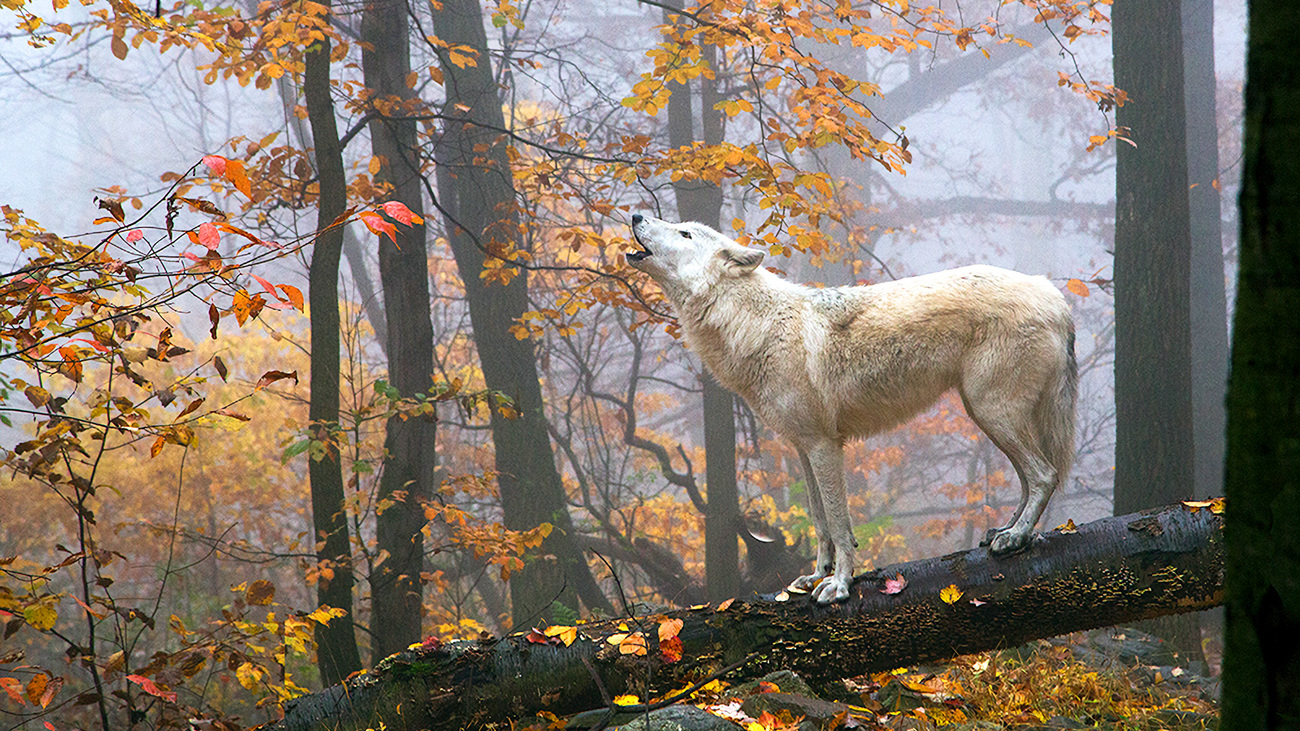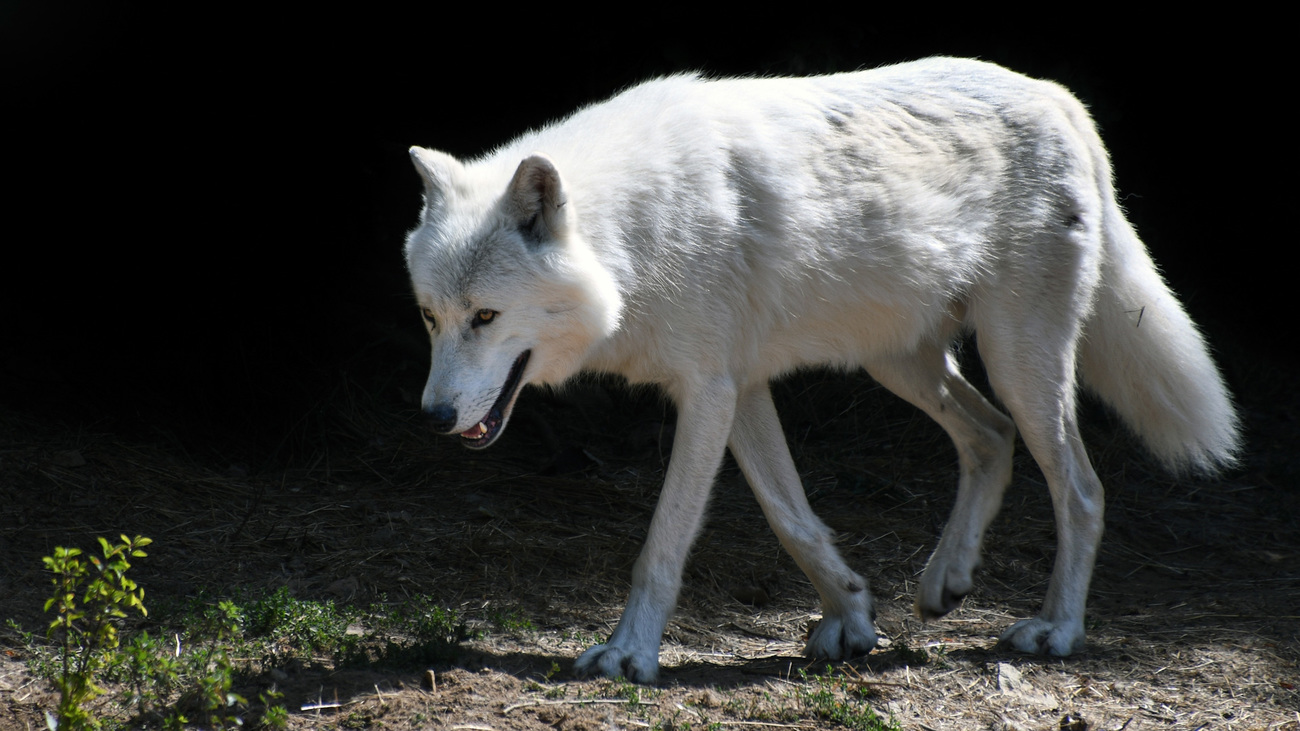Arctic wolves
Also known as white wolves or polar wolves, Arctic wolves are a subspecies of grey wolves that roam the vast, frozen landscape of the Arctic. Like other grey wolves, Arctic wolves are nocturnal pack animals that hunt together, follow the lead of an alpha male, and communicate by howling. They all care for the pack’s pups, taking turns to protect and feed them. Because of their extreme habitat, Arctic wolves also have distinctive appearances and behaviours that distinguish them from other grey wolves.
Living in the High Arctic region covering the Canadian Arctic, parts of Alaska, and the northern coast of Greenland, these white wolves must withstand average winter temperatures of -30°C (-22°F) and several months with no sunlight. Their thick white coat and furry paws are essential for both insulation and camouflage in their almost permanently snow-covered habitat. Arctic wolves are smaller than other grey wolves and have smaller ears and shorter noses. These adaptations allow them to lose less body heat, while their extra layer of fat works as both insulation and food storage for the long Arctic winters when food can be scarce.
Capable of surviving in some of the harshest, most extreme conditions on Earth, this subspecies of grey wolves is integral to the Arctic ecosystem. As carnivorous hunters, they play a vital role in their environment by helping to control populations of animals in the region, such as caribou, musk oxen, and Arctic hares.
The lucky few who have observed Arctic wolves in the wild note how playful and unafraid of humans they are. Unlike other wolves who have to deal with human encroachment every day, Arctic wolves have no intrinsic distrust of humans. Their harsh environment means that they have never been hunted or displaced by agricultural development, and they have never faced endangerment as a result. However, the world’s changing climate and the increasing industrialisation of the Arctic are likely to have devastating effects on the future of the Arctic wolf and its habitat.
What is the Arctic wolf’s scientific name?
The scientific name for the Arctic wolf is Canis lupus arctos. The genus Canis comes from the Latin word for dog, while the subspecies name lupus arctos is Latin for ‘wolf of the Arctic’.
Are Arctic wolves endangered?
As a subspecies of grey wolves, Arctic wolves are listed on the IUCN Red List of endangered species as least concern. They were listed as vulnerable from 1982 to 1995, but their status was upgraded to least concern in 1996 and has remained the same ever since.
Thanks to their remote, icy habitat, Arctic wolves live far away from any human populations. This means they don’t face the same threats as wolves living in closer proximity to humans. However, they are still threatened by climate change, the consequences of which could alter their status in the coming years.
Where do Arctic wolves live?
The Arctic wolf’s habitat is one of the most remote in the world. It spans the Canadian Arctic region, including Ellesmere Island and Devon Island, parts of Alaska, and the western and northern shores of Greenland. Because of its remoteness, Arctic wolves rarely encounter humans and, unlike most grey wolves, can roam freely across the territories they inhabit. In fact, Arctic wolves are the only subspecies of grey wolves that can be found across the entirety of their original range.
Average temperatures in this high Arctic region are around -30°C (-22°F) in winter but can feel a lot colder because of wind chill. In the summer, temperatures reach a maximum of around 2°C (35.6°F). This far north, the winters are long and shrouded in almost continual darkness, while ice and snow permanently cover most of the area.
The brief summer period from mid-June to mid-August provides a degree of respite from the dark and freezing winters. As well as extended hours of daylight, the usually snowy landscapes melt to reveal low-growing plants, providing the Arctic wolf’s preferred prey with more food and making it easier for wolves to hunt.
With that said, Arctic wolves are so well-adapted to the harsh, barren, and freezing environment they inhabit that they can withstand months of bitter temperatures and darkness. When necessary, they can survive for up to several weeks without food.
Threats
Since Arctic wolves live in a remote habitat that is far removed from humans, they don’t face the same threats as other wolves, such as human encroachment, agricultural development, or hunting. However, they do face two significant threats—industrial development and climate change.

Industrial development
The construction of new mines, access roads, and underground pipelines in the increasingly industrialised Arctic region is causing disruptions in the remote areas where Arctic wolves live. As well as encroaching on the territory that Arctic wolves inhabit, this industrial development interrupts their food supply, threatening their survival.
Climate change
Climate change—and the consequent extreme weather variations—has made it more difficult for Arctic hares and musk oxen to find food, causing their population numbers to decline. As these animals are two of the Arctic wolf’s main sources of food, their decreasing populations puts Arctic wolves at risk. Moreover, Arctic wolves are so well-adapted to life in the bitter cold of the Arctic that any change to their natural climate could be catastrophic for their ongoing survival.
FAQs
Find out more about these fascinating creatures with these quick Arctic wolf facts.
What do Arctic wolves eat?
Arctic wolves are carnivorous hunters. They mainly prey on musk oxen and Peary caribou, but they also eat Arctic hares, seals, waterfowl, ptarmigans, and lemmings.
How big are Arctic wolves?
The average Arctic wolf is between 60 and 91 centimetres (24 and 36 inches) tall. From head to toe, they measure 100 to 180 centimetres (38 to 71 inches) long. The average weight of a fully grown male ranges from 32 to 70 kilograms (70 to 55 pounds).

Do polar bears eat Arctic wolves?
Polar bears are the only predator of the Arctic wolf and would find it easy to hunt and kill Arctic wolves—especially pups—thanks to their acute sense of smell and immense size. However, Arctic wolves provide little nutritional value for polar bears and would only ever be hunted as a last resort in times of extreme food scarcity.
Where do Arctic wolves sleep?
Arctic wolves are unable to dig dens in the permanently frozen soil of their natural habitat, so they often sleep in caves, in shallow ground depressions, or beneath rocky ridges.
Are Arctic wolves nocturnal?
Like other grey wolves, Arctic wolves are nocturnal, as it’s easier to hunt at night when their prey are less prepared for attack. Arctic wolves have excellent eyesight, which comes in handy when hunting during the Arctic’s long period of constant darkness from the end of October to the end of March.
Can Arctic wolves swim?
Arctic wolves can swim. This BBC report reveals how a crew filming a nature documentary on Ellesmere Island in the Canadian Arctic observed Arctic wolves swimming in an attempt to catch waterfowl. While they mainly stalk their prey on dry land, the Arctic wolf’s swimming ability allows them to hunt various types of prey.
There’s also genetic evidence to suggest that Arctic wolves scattered across the islands in the Canadian Arctic, including on Banks Island and Victoria Island, move between these islands—likely by swimming—to maximise their chances of catching prey.
Do Arctic wolves change colour?
Arctic wolves have white coats all year round. This is in contrast to Arctic foxes who are white for most of the year but develop a grey coat in the summer months.
As well as keeping them warm, the Arctic wolves’ thick white coats work as the perfect camouflage in their almost permanently snow-covered, frozen habitat.
Do Arctic wolves hibernate?
Arctic wolves have adapted so well to their environment that they don’t need to hibernate during the freezing winter months when prey can be scarce. They can survive up to a few weeks without food.
Do Arctic wolves hunt in packs?
Like other subspecies of wolves, Arctic wolves live and hunt in small family groups of around six to ten individuals, although packs can sometimes include up to more than twice this number.
Wolf packs operate on a strict hierarchy, with a dominant alpha male at the top alongside his alpha female mate—the group’s breeding pair. The rest of the pack includes their offspring of various ages.
Both male and female Arctic wolves are very active in hunting prey. In winter, when food is more scarce, packs will hunt together to secure a kill. In summer, however, when there are more opportunities to catch prey, hunts are often conducted alone.
To secure enough prey for the pack, Arctic wolves roam long distances of up to 19 kilometres (12 miles) per day.
Do Arctic wolves migrate?
Arctic wolves do not migrate, but the scarcity of their prey—especially in winter—forces them to hunt across large areas of up to 2,600 square kilometres (1,000 square miles) in search of food. In winter, packs will also follow migrating caribou when they head further south to ensure that the pack has a consistent food source.
How do Arctic wolves communicate?
Like other wolves, Arctic wolves communicate by howling. The sound of their howl can travel up to 10 kilometres (six miles), making this a useful tool for them to send messages across the long distances they cover every day. A lone Arctic wolf will often howl to attract the attention of his pack, while communal howls can be confrontational, sending territorial messages from one pack to another.
How do Arctic wolves reproduce?
Each pack of wolves has a breeding pair made up of the alpha male and alpha female, who are the only individuals in the pack that reproduce. They typically breed between February and April, with the female giving birth to a litter of five or six pups in the spring after a two-month gestation period. Since the frozen earth makes underground dens difficult to dig, Arctic wolves’ pups are often born in caves, in natural holes or burrows, or beneath rocky ridges.
After they are weaned from their mother’s milk at six to nine weeks, the adult members of the pack work together to supply the pups with a diet of regurgitated meat. Throughout the spring and summer, the newborn pups are the pack’s focus—both in terms of their attention and their geographical positioning, since the pups are too small to travel far. By October or November, most Arctic wolf pups are adult-sized and ready to survive their first Arctic winter.
After spending two or three years in the pack, many Arctic wolves will leave to search for a mate and possibly even start their own pack.
How do Arctic wolves stay warm?
Arctic wolves are fascinating because of their ability to stay warm in freezing temperatures. They can survive the cold thanks to several anatomical and physiological adaptations.
One of these is their thick, furry coat, which consists of an inner layer of shorter hairs for insulation and an outer layer of waterproof and snow-proof longer hairs. Arctic wolves also have furry paws that keep them warm while traversing the snow and ice and a thick layer of body fat for further insulation.
How long do Arctic wolves live?
Although they can survive for much longer in captivity, Arctic wolves live for around six to eight years in the wild.
How many Arctic wolves are left in the world?
Their extreme environment makes Arctic wolves difficult to study and count. While the IUCN doesn’t have an estimate for how many Arctic wolves are left, research does suggest that their population is decreasing.
How can you help?
Though they aren’t currently endangered, the Arctic wolf population is decreasing, and they face the looming threat of climate change. IFAW is working around the world to make communities and ecosystems more climate-resilient.
